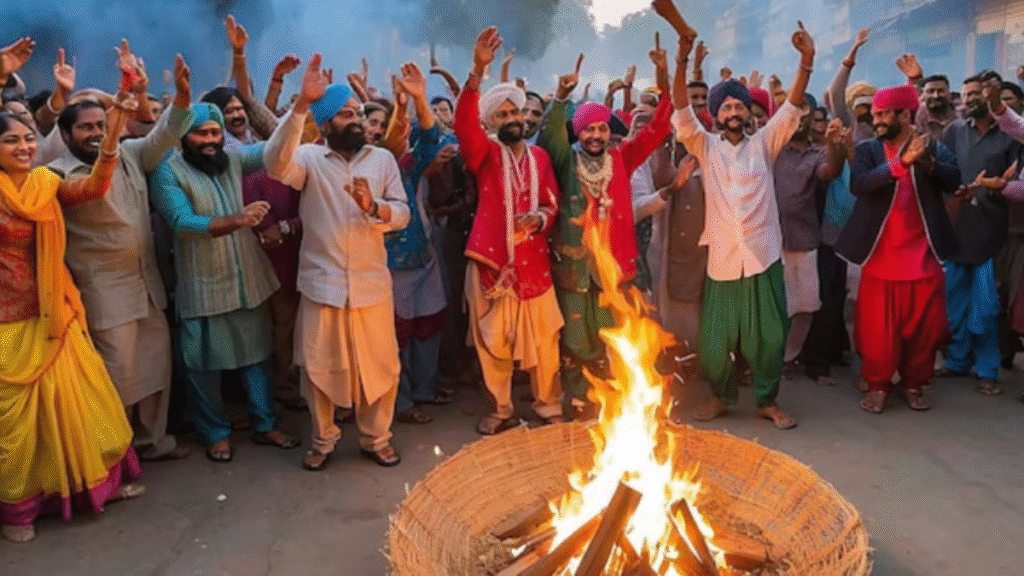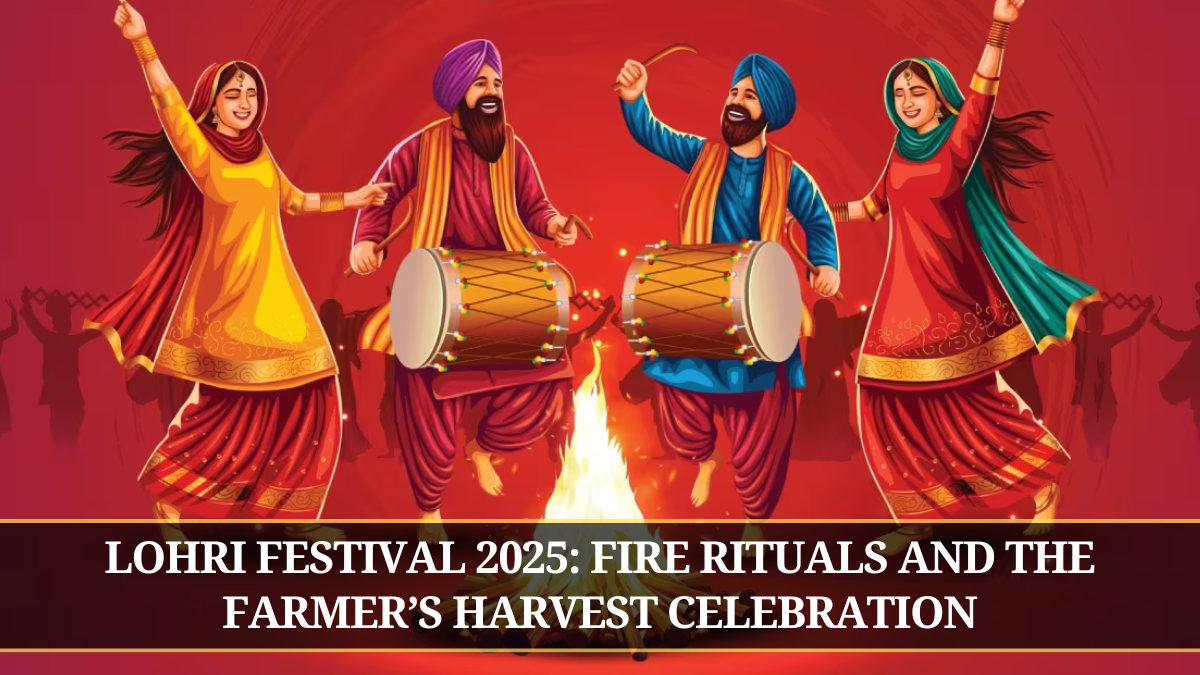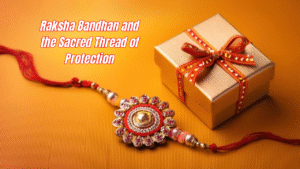Why is Lohri celebrated? Lohri is a well -known autumn festival that was celebrated on January 13 in Punjab and North India. This reflects the end of winter and celebrates the Rabi crop, especially sugar cane and wheat.
It is celebrated with bonfires, folk songs, sweets and group dances. Lohri also indicates a new beginning, especially for the newborn and newlywed couples, and Dulla Bhatti has a deep connection with public history.
Why is Lohri celebrated?
There are many reasons behind Punjab’s favorite festival, Lohri. One is that it is named after St. Kabir’s wife, “Loi”. Another theory stated that it is taken from “Loh”, a tool is used to roll chaaptis. Other people associate it with the legend of Holika’s sister, who was saved from flames.

This name can also be taken from “Tilorhi”, a combination of sesame and jaggery. For farmers, Lohri is the beginning of the new financial year and the crop season, and therefore a day of celebration and thanks.
When is Lohri celebrated?
Lohri is celebrated every year on a specific date, and usually falls January 13 or January 14.
Here is a certain date a little different:
- Lohri is connected to the Hindu solar calendar. This solar calendar differs slightly from the Gregorian calendar that is often used.
- It comes a day before Makar Sankranti: Makar Sankranti is a fixed date (January 14), so Lohri falls the day before.
- The weak variations in the solar calendar vary from one or two days after another year.
In recent times, Lohri has fallen:
- 2023: January 13
- 2024: 14 January
- 2025: 13 January
What is the origin of Lohri?
Why Is Lohri Celebrated? The history of Lohri is as vibrant as the festival itself, spun into the rich tapestry of Punjab’s past. According to legend, the festival has been named after Loi, the wife of Sant Kabir, or perhaps after Holika, the sister of the mythological demon king Hiranyakashipu.
Yet, the most popular account connects Lohri with the legend of Dulla Bhatti, the famous hero of Punjab folk tales. Dulla Bhatti, the Punjab Robin Hood, was famous for saving young girls from being sold into slavery during Mughal Emperor Akbar’s rule. The Lohri festival is said to be a celebration of his heroic acts, and traditional Lohri songs frequently speak of his name.
- “Sundar mundriye ho! Tera kaun vicharaa ho!
- Dulla Bhatti wala ho! Dullhe di dhee vyayae ho!
- Ser shakkar payee ho!”
- Lohri is associated with the Hindu solar calendar: The solar calendar varies marginally from the widely applied Gregorian calendar.
- It occurs one day prior to Makar Sankranti: Makar Sankranti occurs on a fixed date (January 14th), and Lohri, therefore, occurs on the previous day.
The minor variations in the solar calendar result in the date moving by one or two days every few years.
- 2023: January 13th
- 2024: January 14th
These verses from a well-known Lohri song praise the heroism of Dulla Bhatti, providing a cultural dimension to celebrations during the festival.
Significance of the Lohri Festival
why is lohri celebrated
Why is Lohri Celebrated? Lohri is an extremely significant festival for a variety of reasons:
- Celebrating the Harvest (Rabi Crops):
Lohri is primarily a harvest festival. It is a festival of thanks offering for a bountiful harvest of winter crops such as wheat and mustard, cultivated in the preceding months. Farmers thank God for the good harvest and seek blessings for more prosperity in the future. - The Celebration of Seasonal Change
Lohri formerly used to commemorate the winter solstice, the shortest day of the year. As days start getting longer and warmer, Lohri is celebrated, bidding farewell to cold winter and greeting the approaching spring. - A Time of New Beginnings:
Lohri is significant in the case of families with new babies or newlywed couples. The heat of the fire is thought to ward off evil spirits and imbue good fortune for fresh starts.
How do people celebrate Lohri?
Lohri is a festive celebration by families, friends, and relatives throughout India. It’s particularly significant for farmers as a festival to commemorate the harvest. They people set bonfires alight, sing, dance, and toss sweets, sesame seeds, and jaggery into the fire.
The celebration is also significant for newlywed couples and families with a new baby. The couple is gifted by loved ones, who bless them for a bright and prosperous future. It is a time for celebration and wishes.
Lohri traditions
- The Bonfire (Dhruh):
A central theme of Lohri is the bonfire, or “Dhruh.” Individuals sit around this blazing fire and add treats such as puffed rice (Rewari), peanuts, and popcorn as an offering. The fire symbolizes the warmth of the sun, dispelling negativity and bestowing good fortune. - Sweets and Treats
Lohri is not complete without sweets. Families and friends make and share special sweets such as peanuts, Rewari (peanut-jaggery mixture), and til chikki (sesame seeds). These sweets bring happiness and harmony among all. - Songs and Dances:
Lohri is a festival of happiness and celebration. Individuals wear vibrant colors, sing traditional Punjabi folk music like “Sundar Mundriye” and “Lohri di Raat,” and dance vigorously to Bhangra and Gidda music. The festive atmosphere pervades the air with joy and camaraderie.
Simply put, Lohri is all about gathering, feasting on scrumptious food, dancing, and rejoicing in the warmth of fellow human beings around a warm bonfire.
Lohri Across North India: Regional Variations
While Lohri’s main traditions remain the same, there are some interesting ways it is celebrated in different parts of North India. Let’s find out how Lohri is celebrated in various states:

- Punjab:
In Punjab, which is where Lohri is most prominent, the celebrations are energetic. People get together in large groups, set up bonfires in streets and compounds, and dance to dhol rhythms. Bhangra and Gidda dances are also part of the party. - Himachal Pradesh:
Lohri is referred to as “Maghi” in Himachal Pradesh and falls on sugarcane harvesting time. People set fire to bonfires and worship the fire god, Agni. They also celebrate traditional dances like Natiyana. - Haryana:
In Haryana too, Lohri is observed with the same fervor. Women assemble around bonfires, sing traditional songs, and relish sweets such as peanuts and Rewari. They also indulge in special sugarcane juice known as “gur ki raab” during the celebrations.
These differences reflect how Lohri is celebrated differently across various parts of North India.
What is the moral of Lohri festival?
The ethos of the Lohri festival is one of gratitude, rebirth, and optimism. It instructs us to thank God for the harvest and the gifts of nature, and to rejoice in new beginnings.
Lohri encourages us to remain optimistic, accept change, and look ahead to times that will be better, and the glow and warmth of the bonfire representing hope for a brighter tomorrow.
Lohri Beyond Borders
Lohri is a joyous and thankful festival celebrated globally. Here’s how Lohri spreads love to everyone across the globe:
- International Punjabi Community:
Punjabis globally celebrate Lohri traditions. In town and cities, they come together with bonfires, traditional meals, and cultural events. These festivities make them feel home and happy about their culture. - Acceptance of Diversity:
Lohri is inclusive of all people. It’s all about celebration, good food, and lively traditions. You are welcome whether you are attending a Punjabi friend’s party or a neighborhood Lohri celebration. You will be made welcome and have a special cultural experience. - Sharing the Cheer:
Lohri teaches us hope, strength, and appreciation of nature’s gifts. Celebrating Lohri promotes awareness about Punjabi culture and highlights the festival’s important values.
Here are ways to celebrate Lohri:
- Connect with Local Punjabi Communities: Find Punjabi groups or cultural centers nearby. They often host Lohri events that are open to everyone.
- Host a Small Lohri Party: Invite your loved ones and adhere to neighborhood regulations to host a small bonfire, prepare easy Lohri snacks, and exchange anecdotes.
- Master Bhangra Footwork: Bhangra, a dynamic Punjabi dance, forms a part of Lohri. Master simple steps to incorporate fun into your festivities.
- Bringing Cultures Together
Lohri connects cultures, bringing together understanding and sharing. Participating in Lohri festivities preserves Punjabi culture and heritage and adds value to your cultural experience. Come on and join in the festivities and experience a new festival with love, joy, and community spirit.
Why do Sikhs celebrate Lohri?
Why is Lohri Celebrated? Although Lohri is a Punjabi festival, it is also celebrated by Sikhs throughout India. It is usually celebrated on January 13th. Lohri celebrates the end of winter and the harvest season, particularly the sugarcane crop.
The farmers celebrate lighting bonfires, playing traditional music and dancing, and distributing sweets. Why is Lohri Celebrated?
Is Lohri a Sikh Festival?
Lohri is not a religious festival only specifically associated with Sikhism or any religion. Rather, it is a seasonal and cultural one that has deep roots in Punjabi agrarian culture. Celebrated with great zest throughout Punjab, Haryana, Delhi, and Himachal Pradesh, it is celebrated by Sikhs, Hindus, and other segments of the population.
Though Sikhism as a faith does not encourage ritualistic celebrations, most Sikh families observe Lohri as a communal celebration of harvest blessings, social bonding, and family accomplishments like births and weddings. Though Gurudwaras do not officially sponsor Lohri celebrations, families and neighborhoods come together around campfires, eat foods such as til, gur, and rewri, and sing Punjabi folksongs together.
The festival is also significant in rural areas where farming is the main livelihood. Thus, Lohri’s essence lies more in seasonal gratitude and cultural togetherness than in religious doctrine. It reflects the region’s folk identity, aligning more with agrarian practices than with any particular theology.
What is the scientific cause of Lohri?
The scientific reason behind Lohri is associated with winter Sankranti. Lohri reflects the shift for warm, long -day entrance from the summit in winter. It comes January 13, when the sun begins to move in the north direction, shows more light and warmth.
This turn is observed in the season as it indicates the end of winter and the beginning of the crop season. Why is Lohri celebrated? The fire represents light and heat, closes the cold, and soon embraces for a long time bright days.
Lohri and Sun Movement: a scientific perspective
Lohri is well related to the solar calendar and the sun (the sun) is the beginning of the northern hemisphere, Uttarayan. Although Lohri falls January 13, the day after, Makar Sankranti Maker, when the sun enters the Capricorn.
This movement indicates the end of severe winter and the beginning of extended hot days, which is the largest importance for agrarian cycles. Therefore, Lohari is of scientific importance to indicate the outbreak of changes in the weather and the beginning of renovation of energy.
Lohari for kids: Special blessing ceremony
In the Punjabi culture, Lohri is observed especially for infants, especially if this is the first lohri-after birth. The fire is burned by families as a sign of happiness and safety, and they ask for good health, success and life for the child.
Relatives exchange gifts, jaggery and sweets, while women sing folk tunes to welcome the new soul in the family. In modern times, Lohri is celebrated the same for girls and boys, marked as a progressive cultural opportunity.
Read More:- Chapchar Kut: Mizoram’s Spring Festival of Dance and Joy
Search for traditions and good luck to Lohri
If you want to go deep on why Lohri is celebrated, there are some interesting topics here:
- The Legend of Dullla Bhatti: Learn more about his relationship with the legendary Punjabi Nayak and the Lohri celebration.
- Classic Lohri songs: Walk into Lohri’s mood by listening to famous Punjabi people like “Sundar Mundri” and “Lohri di Rat”.
- Lohri Happy Recipes: Lohri sweets like rewari and chikki are shooting. There are different recipes with simple steps available online.
conclusion
Lohri is a beautiful festival that brings together tradition and modern celebrations. Thanks and happiness, there is a moment of rebirth and prosperity. When fire cracks and drums strike, Lohri just teaches us to accept positivity, value conditions and to accept the expectation of a bright future.
Best wishes for everyone! This festival can fill your life with warmth, happiness and huge ceremonies!
FAQs:-
What is the date of Lohri in 2025?
Lohri will be celebrated on Tuesday, January 14, 2025, marking the end of winter and the harvest season.
What is the significance of the bonfire during Lohri?
The bonfire symbolizes warmth, energy, and prosperity, and people offer food to thank the fire god.
What is the connection between Lohri and Makar Sankranti?
Lohri is celebrated a day before Makar Sankranti, marking the sun’s transition into Capricorn.

